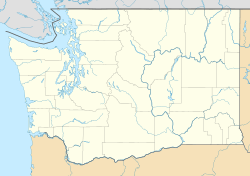Caples, Washington facts for kids
Quick facts for kids
Caples, Washington
|
|
|---|---|
| Country | United States |
| State | Washington |
| County | Cowlitz |
| Elevation | 6 m (20 ft) |
| Time zone | UTC−8 (PST) |
| • Summer (DST) | UTC−7 (PDT) |
| ZIP code |
98674
|
| Area code(s) | 360 |
| GNIS feature ID | 1513509 |
Caples is a small, unincorporated community in Cowlitz County, Washington. This means it's a place where people live, but it doesn't have its own local government like a city or town. Caples is located about 2.5 miles (4 kilometers) west of Woodland. It sits right on the eastern shore of the Columbia River. Across the river, you can see Columbia City, Oregon. The students in Caples attend schools in the Woodland School District. This district serves about 2,200 students from kindergarten through 12th grade.
History of Caples
Caples Landing
Caples Landing was an important spot on the Columbia River. It was a place where steamboat passengers would get on or off the boats. Steamboats were a common way to travel and transport goods in the past.
In 1901, a sad event happened at Caples Landing. A passenger named Gordon Smith was getting on the steamboat Lurline. He accidentally fell overboard and drowned.
The Railroad Idea
The community of Caples is named after Charles Caples. He was a doctor who lived in Columbia City, Oregon. In 1860, Charles Caples and his brother Hezekiah Caples had a big idea. They wanted to build a railroad along the Columbia River.
In 1868, their company, the Columbia River and Hillsboro Railroad, was officially formed. The plan was for the railroad to connect Hillsboro, Oregon to either Caples Landing or Columbia City. However, this railroad project did not succeed.
Even though that first attempt failed, Charles Caples didn't give up on railroads. In 1883, he was involved with the Northern Pacific Railway extension. This extension helped connect the railway to Columbia City.
A Historic Home
Today, Charles Caples' old farmhouse is still standing. It is now recognized as a registered historic place. This means it's an important building that tells us about the history of the area.



